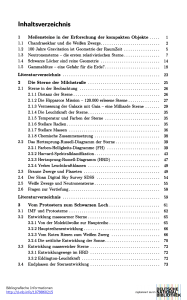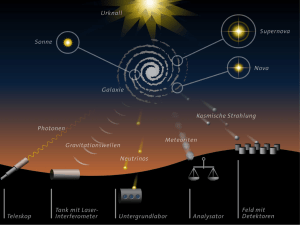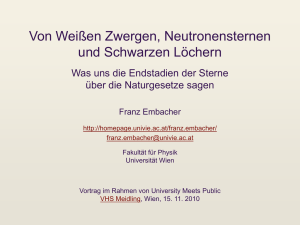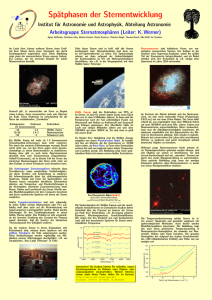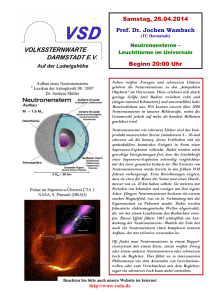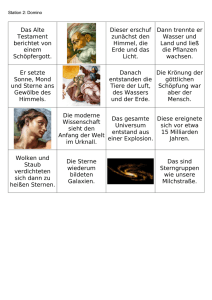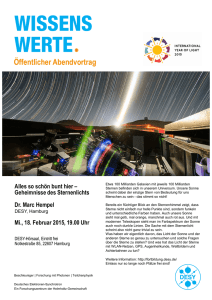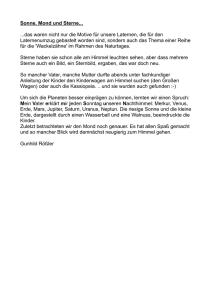Inhaltsverzeichnis
Werbung
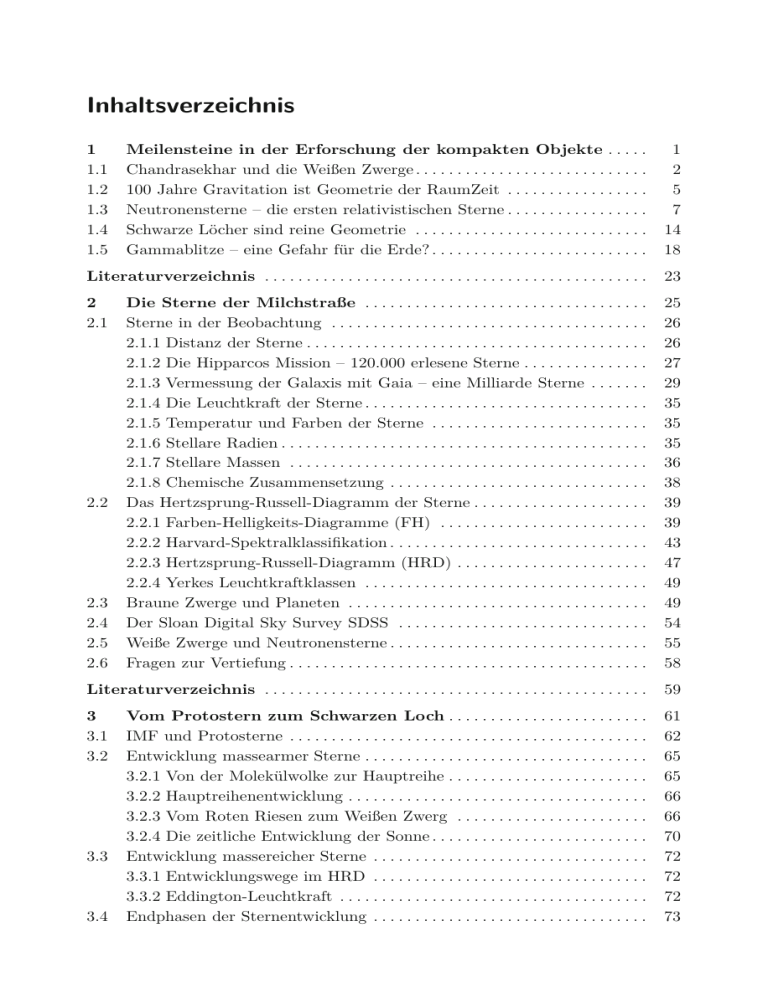
Inhaltsverzeichnis Meilensteine in der Erforschung der kompakten Objekte . . . . . Chandrasekhar und die Weißen Zwerge . . . . . . . . . . . . . . . . . . . . . . . . . . . . 100 Jahre Gravitation ist Geometrie der RaumZeit . . . . . . . . . . . . . . . . . Neutronensterne – die ersten relativistischen Sterne . . . . . . . . . . . . . . . . . Schwarze Löcher sind reine Geometrie . . . . . . . . . . . . . . . . . . . . . . . . . . . . Gammablitze – eine Gefahr für die Erde? . . . . . . . . . . . . . . . . . . . . . . . . . . 1 2 5 7 14 18 Literaturverzeichnis . . . . . . . . . . . . . . . . . . . . . . . . . . . . . . . . . . . . . . . . . . . . . . 23 Die Sterne der Milchstraße . . . . . . . . . . . . . . . . . . . . . . . . . . . . . . . . . . Sterne in der Beobachtung . . . . . . . . . . . . . . . . . . . . . . . . . . . . . . . . . . . . . . 2.1.1 Distanz der Sterne . . . . . . . . . . . . . . . . . . . . . . . . . . . . . . . . . . . . . . . . . 2.1.2 Die Hipparcos Mission – 120.000 erlesene Sterne . . . . . . . . . . . . . . . 2.1.3 Vermessung der Galaxis mit Gaia – eine Milliarde Sterne . . . . . . . 2.1.4 Die Leuchtkraft der Sterne . . . . . . . . . . . . . . . . . . . . . . . . . . . . . . . . . . 2.1.5 Temperatur und Farben der Sterne . . . . . . . . . . . . . . . . . . . . . . . . . . 2.1.6 Stellare Radien . . . . . . . . . . . . . . . . . . . . . . . . . . . . . . . . . . . . . . . . . . . . 2.1.7 Stellare Massen . . . . . . . . . . . . . . . . . . . . . . . . . . . . . . . . . . . . . . . . . . . 2.1.8 Chemische Zusammensetzung . . . . . . . . . . . . . . . . . . . . . . . . . . . . . . . Das Hertzsprung-Russell-Diagramm der Sterne . . . . . . . . . . . . . . . . . . . . . 2.2.1 Farben-Helligkeits-Diagramme (FH) . . . . . . . . . . . . . . . . . . . . . . . . . 2.2.2 Harvard-Spektralklassifikation . . . . . . . . . . . . . . . . . . . . . . . . . . . . . . . 2.2.3 Hertzsprung-Russell-Diagramm (HRD) . . . . . . . . . . . . . . . . . . . . . . . 2.2.4 Yerkes Leuchtkraftklassen . . . . . . . . . . . . . . . . . . . . . . . . . . . . . . . . . . Braune Zwerge und Planeten . . . . . . . . . . . . . . . . . . . . . . . . . . . . . . . . . . . . Der Sloan Digital Sky Survey SDSS . . . . . . . . . . . . . . . . . . . . . . . . . . . . . . Weiße Zwerge und Neutronensterne . . . . . . . . . . . . . . . . . . . . . . . . . . . . . . . Fragen zur Vertiefung . . . . . . . . . . . . . . . . . . . . . . . . . . . . . . . . . . . . . . . . . . . 25 26 26 27 29 35 35 35 36 38 39 39 43 47 49 49 54 55 58 Literaturverzeichnis . . . . . . . . . . . . . . . . . . . . . . . . . . . . . . . . . . . . . . . . . . . . . . 59 Vom Protostern zum Schwarzen Loch . . . . . . . . . . . . . . . . . . . . . . . . IMF und Protosterne . . . . . . . . . . . . . . . . . . . . . . . . . . . . . . . . . . . . . . . . . . . Entwicklung massearmer Sterne . . . . . . . . . . . . . . . . . . . . . . . . . . . . . . . . . . 3.2.1 Von der Molekülwolke zur Hauptreihe . . . . . . . . . . . . . . . . . . . . . . . . 3.2.2 Hauptreihenentwicklung . . . . . . . . . . . . . . . . . . . . . . . . . . . . . . . . . . . . 3.2.3 Vom Roten Riesen zum Weißen Zwerg . . . . . . . . . . . . . . . . . . . . . . . 3.2.4 Die zeitliche Entwicklung der Sonne . . . . . . . . . . . . . . . . . . . . . . . . . . Entwicklung massereicher Sterne . . . . . . . . . . . . . . . . . . . . . . . . . . . . . . . . . 3.3.1 Entwicklungswege im HRD . . . . . . . . . . . . . . . . . . . . . . . . . . . . . . . . . 3.3.2 Eddington-Leuchtkraft . . . . . . . . . . . . . . . . . . . . . . . . . . . . . . . . . . . . . Endphasen der Sternentwicklung . . . . . . . . . . . . . . . . . . . . . . . . . . . . . . . . . 61 62 65 65 66 66 70 72 72 72 73 1 1.1 1.2 1.3 1.4 1.5 2 2.1 2.2 2.3 2.4 2.5 2.6 3 3.1 3.2 3.3 3.4 viii Inhaltsverzeichnis 3.4.1 Planetarische Nebel und Weiße Zwerge . . . . . . . . . . . . . . . . . . . . . . . 3.4.2 Supernovae und Neutronensterne . . . . . . . . . . . . . . . . . . . . . . . . . . . . 3.4.3 Hypernovae und Schwarze Löcher . . . . . . . . . . . . . . . . . . . . . . . . . . . . 3.4.4 Die ersten Sterne und Schwarzen Löcher im Universum . . . . . . . . . Fragen zur Vertiefung . . . . . . . . . . . . . . . . . . . . . . . . . . . . . . . . . . . . . . . . . . . 74 75 80 82 84 Literaturverzeichnis . . . . . . . . . . . . . . . . . . . . . . . . . . . . . . . . . . . . . . . . . . . . . . 85 Gravitation kompakter Objekte . . . . . . . . . . . . . . . . . . . . . . . . . . . . . . Die Galilei’sche Relativität . . . . . . . . . . . . . . . . . . . . . . . . . . . . . . . . . . . . . . Das Einstein’sche Relativitätsprinzip . . . . . . . . . . . . . . . . . . . . . . . . . . . . . 4.2.1 Die Suche nach dem Äther . . . . . . . . . . . . . . . . . . . . . . . . . . . . . . . . . . 4.2.2 Die Spezielle Relativität . . . . . . . . . . . . . . . . . . . . . . . . . . . . . . . . . . . . 4.2.3 Zeitdilatation – bewegte Uhren gehen langsamer . . . . . . . . . . . . . . . 4.2.4 Längenkontraktion – bewegte Körper erscheinen verkürzt . . . . . . . 4.2.5 Die Lorentz-Transformationen . . . . . . . . . . . . . . . . . . . . . . . . . . . . . . . 4.2.6 Additionstheorem der Geschwindigkeiten . . . . . . . . . . . . . . . . . . . . . 4.2.7 Ohne Spezielle Relativität keine Beschleuniger . . . . . . . . . . . . . . . . 4.2.8 Compton- und Doppler-Effekt . . . . . . . . . . . . . . . . . . . . . . . . . . . . . . . 4.2.9 Spezielle Relativität ist lebensnotwendig . . . . . . . . . . . . . . . . . . . . . . Ohne Gravitation ist die Welt flach . . . . . . . . . . . . . . . . . . . . . . . . . . . . . . . 4.3.1 Die RaumZeit von Minkowski . . . . . . . . . . . . . . . . . . . . . . . . . . . . . . . 4.3.2 Die kausale Struktur der Minkowski RaumZeit . . . . . . . . . . . . . . . . 4.3.3 Denken Sie in 1+2 Dimensionen! . . . . . . . . . . . . . . . . . . . . . . . . . . . . Gauß und Riemann – die Vordenker Einsteins . . . . . . . . . . . . . . . . . . . . . . 4.4.1 Wie messe ich Distanzen auf gekrümmten Flächen? . . . . . . . . . . . . 4.4.2 Die Klein’sche Flasche . . . . . . . . . . . . . . . . . . . . . . . . . . . . . . . . . . . . . 4.4.3 Die Tangentialebene an die Fläche . . . . . . . . . . . . . . . . . . . . . . . . . . . 4.4.4 Die Gauß’sche Krümmung einer Fläche . . . . . . . . . . . . . . . . . . . . . . . 4.4.5 Konzept der Riemann’schen Mannigfaltigkeit . . . . . . . . . . . . . . . . . . 4.4.6 Die Kugeloberfläche als 2-D-Mannigfaltigkeit . . . . . . . . . . . . . . . . . . 4.4.7 Transport von Vektoren und Krümmung . . . . . . . . . . . . . . . . . . . . . Die Äquivalenzprinzipien von Albert Einstein . . . . . . . . . . . . . . . . . . . . . . 4.5.1 Das Schwache Äquivalenzprinzip . . . . . . . . . . . . . . . . . . . . . . . . . . . . . 4.5.2 Das Einstein’sche Äquivalenzprinzip . . . . . . . . . . . . . . . . . . . . . . . . . 4.5.3 Das Starke Äquivalenzprinzip . . . . . . . . . . . . . . . . . . . . . . . . . . . . . . . Die RaumZeit der Allgemeinen Relativitätstheorie . . . . . . . . . . . . . . . . . . 4.6.1 Gravitation ist Geometrie der RaumZeit . . . . . . . . . . . . . . . . . . . . . . 4.6.2 Der Transport von Vektoren ist metrisch . . . . . . . . . . . . . . . . . . . . . 4.6.3 Körper bewegen sich auf Geodäten in der RaumZeit . . . . . . . . . . . 4.6.4 Die Einstein’schen Feldgleichungen . . . . . . . . . . . . . . . . . . . . . . . . . . Einstein auf dem Prüfstand . . . . . . . . . . . . . . . . . . . . . . . . . . . . . . . . . . . . . . 4.7.1 Lichtablenkung am Sonnenrand . . . . . . . . . . . . . . . . . . . . . . . . . . . . . 87 89 90 91 94 97 98 99 101 103 105 107 108 108 111 111 113 114 117 118 120 124 125 127 128 129 132 133 133 134 136 136 137 142 143 3.5 4 4.1 4.2 4.3 4.4 4.5 4.6 4.7 Inhaltsverzeichnis 4.8 4.7.2 Apsidendrehung der Merkurbahn . . . . . . . . . . . . . . . . . . . . . . . . . . . . 4.7.3 Shapiro-Effekt – Radiosignale verzögern sich . . . . . . . . . . . . . . . . . . 4.7.4 Tests des Starken Äquivalenzprinzips . . . . . . . . . . . . . . . . . . . . . . . . . 4.7.5 Gravity Probe B misst Krümmung und Frame-Dragging der Erde Fragen zur Vertiefung . . . . . . . . . . . . . . . . . . . . . . . . . . . . . . . . . . . . . . . . . . . ix 145 146 147 148 149 Literaturverzeichnis . . . . . . . . . . . . . . . . . . . . . . . . . . . . . . . . . . . . . . . . . . . . . . 151 Weiße Zwerge – Diamanten der Milchstraße . . . . . . . . . . . . . . . . . Was ist Sirius B? . . . . . . . . . . . . . . . . . . . . . . . . . . . . . . . . . . . . . . . . . . . . . . . Bosonen und Fermionen . . . . . . . . . . . . . . . . . . . . . . . . . . . . . . . . . . . . . . . . . Chandrasekhar kämpft gegen das Establishment . . . . . . . . . . . . . . . . . . . Struktur der Weißen Zwerge . . . . . . . . . . . . . . . . . . . . . . . . . . . . . . . . . . . . . Polytropen-Näherung . . . . . . . . . . . . . . . . . . . . . . . . . . . . . . . . . . . . . . . . . . . Die Chandrasekhar-Masse – fundamentales Konzept der Astrophysik . . Warum werden Weiße Zwerge instabil? . . . . . . . . . . . . . . . . . . . . . . . . . . . . Weiße Zwerge in der Milchstraße . . . . . . . . . . . . . . . . . . . . . . . . . . . . . . . . . 5.8.1 Spektraltypen Weißer Zwerge . . . . . . . . . . . . . . . . . . . . . . . . . . . . . . . 5.8.2 Weiße Zwerge in Sonnenumgebung . . . . . . . . . . . . . . . . . . . . . . . . . . . 5.8.3 Weiße Zwerge im Sloan Digital Sky Survey . . . . . . . . . . . . . . . . . . . . 5.9 Kühlung Weißer Zwerge . . . . . . . . . . . . . . . . . . . . . . . . . . . . . . . . . . . . . . . . . 5.10 Fragen zur Vertiefung . . . . . . . . . . . . . . . . . . . . . . . . . . . . . . . . . . . . . . . . . . . 5 5.1 5.2 5.3 5.4 5.5 5.6 5.7 5.8 153 153 156 158 159 161 165 167 169 170 171 171 175 176 Literaturverzeichnis . . . . . . . . . . . . . . . . . . . . . . . . . . . . . . . . . . . . . . . . . . . . . . 177 6 6.1 6.2 6.3 6.4 6.5 Neutronensterne – die kompaktesten Sterne . . . . . . . . . . . . . . . . . Struktur der Neutronensterne . . . . . . . . . . . . . . . . . . . . . . . . . . . . . . . . . . . . Zustandsgleichung Neutronensternmaterie . . . . . . . . . . . . . . . . . . . . . . . . . 6.2.1 Das freie Neutronengas . . . . . . . . . . . . . . . . . . . . . . . . . . . . . . . . . . . . . 6.2.2 Das Tröpfchenmodell für die Krusten . . . . . . . . . . . . . . . . . . . . . . . . 6.2.3 Die Neutronenflüssigkeit im Core . . . . . . . . . . . . . . . . . . . . . . . . . . . . 6.2.4 Quark-Hadronen-Phasenübergang im Zentrum . . . . . . . . . . . . . . . . Tolman-Oppenheimer-Volkoff-Gleichungen . . . . . . . . . . . . . . . . . . . . . . . . . 6.3.1 Die TOV-Gleichungen . . . . . . . . . . . . . . . . . . . . . . . . . . . . . . . . . . . . . . 6.3.2 Dichte-Sequenz der Neutronensterne . . . . . . . . . . . . . . . . . . . . . . . . . 6.3.3 Die kritische Masse von Neutronensternen . . . . . . . . . . . . . . . . . . . . 6.3.4 Massen-Radius-Beziehung und gravitative Rotverschiebung . . . . . Wann rotieren Neutronensterne schnell? . . . . . . . . . . . . . . . . . . . . . . . . . . . 6.4.1 Die Metrik langsam rotierender Sterne . . . . . . . . . . . . . . . . . . . . . . . 6.4.2 Elektrodynamik um rotierende Sterne . . . . . . . . . . . . . . . . . . . . . . . . Neutronensterne als Radiopulsare . . . . . . . . . . . . . . . . . . . . . . . . . . . . . . . . 6.5.1 Was ist ein Pulsar? . . . . . . . . . . . . . . . . . . . . . . . . . . . . . . . . . . . . . . . . 6.5.2 Das Pulsar-Diagramm . . . . . . . . . . . . . . . . . . . . . . . . . . . . . . . . . . . . . . 6.5.3 Der Pulsar als Rotator . . . . . . . . . . . . . . . . . . . . . . . . . . . . . . . . . . . . . 179 181 182 182 183 184 188 191 191 194 195 196 198 201 202 203 204 206 209 x Inhaltsverzeichnis 6.5.4 Spin-Down-Alter und die Entwicklungszeit . . . . . . . . . . . . . . . . . . . . 6.5.5 Die jüngsten und ältesten Pulsare . . . . . . . . . . . . . . . . . . . . . . . . . . . 6.5.6 Struktur der Pulsarmagnetosphäre . . . . . . . . . . . . . . . . . . . . . . . . . . . 6.5.7 MHD-Pulsarwinde . . . . . . . . . . . . . . . . . . . . . . . . . . . . . . . . . . . . . . . . . 6.6 Neutronensterne als Röntgendoppelsterne . . . . . . . . . . . . . . . . . . . . . . . . . 6.6.1 Akkretion auf Neutronensterne . . . . . . . . . . . . . . . . . . . . . . . . . . . . . . 6.6.2 Klassen von Röntgendoppelsternen . . . . . . . . . . . . . . . . . . . . . . . . . . 6.7 Pulsare in Doppelsternsystemen . . . . . . . . . . . . . . . . . . . . . . . . . . . . . . . . . . 6.7.1 Pulsare als Uhren . . . . . . . . . . . . . . . . . . . . . . . . . . . . . . . . . . . . . . . . . 6.7.2 Was ist Pulsar-Timing? . . . . . . . . . . . . . . . . . . . . . . . . . . . . . . . . . . . . 6.7.3 Klassische Bahnelemente im Doppelsternsystem . . . . . . . . . . . . . . . 6.7.4 Post-Kepler’sche Effekte in Binärsystemen . . . . . . . . . . . . . . . . . . . . 6.7.5 Der erste Doppelpulsar . . . . . . . . . . . . . . . . . . . . . . . . . . . . . . . . . . . . . 6.7.6 Ein Dreifachsystem mit Pulsar testet Einstein . . . . . . . . . . . . . . . . . 6.8 Magnetfelder der Neutronensterne . . . . . . . . . . . . . . . . . . . . . . . . . . . . . . . . 6.8.1 Ursprung der Magnetfelder . . . . . . . . . . . . . . . . . . . . . . . . . . . . . . . . . 6.8.2 Zeitliche Entwicklung der Magnetfelder . . . . . . . . . . . . . . . . . . . . . . . 6.8.3 Recycling und Millisekundenpulsare . . . . . . . . . . . . . . . . . . . . . . . . . . 6.8.4 Magnetfelder akkretierender Neutronensterne . . . . . . . . . . . . . . . . . 6.9 Cassiopeia A – der jüngste Neutronenstern in der Milchstraße . . . . . . . . 6.10 Pulsarsuche mit SKA . . . . . . . . . . . . . . . . . . . . . . . . . . . . . . . . . . . . . . . . . . . 6.11 Fragen zur Vertiefung . . . . . . . . . . . . . . . . . . . . . . . . . . . . . . . . . . . . . . . . . . . 211 212 215 219 221 221 222 224 226 226 230 231 236 242 244 246 248 249 251 251 254 256 Literaturverzeichnis . . . . . . . . . . . . . . . . . . . . . . . . . . . . . . . . . . . . . . . . . . . . . . 259 7 7.1 7.2 7.3 7.4 7.5 Schwarze Löcher sind reine Geometrie . . . . . . . . . . . . . . . . . . . . . . . Das nicht-rotierende Schwarze Loch . . . . . . . . . . . . . . . . . . . . . . . . . . . . . . 7.1.1 Die Schwarzschild-Metrik . . . . . . . . . . . . . . . . . . . . . . . . . . . . . . . . . . . 7.1.2 Der Horizont . . . . . . . . . . . . . . . . . . . . . . . . . . . . . . . . . . . . . . . . . . . . . . 7.1.3 Das Kepler-Problem und die Apsidendrehung . . . . . . . . . . . . . . . . . 7.1.4 Lichtablenkung und die Photonensphäre . . . . . . . . . . . . . . . . . . . . . . Schwarze Löcher und modernes Vakuum . . . . . . . . . . . . . . . . . . . . . . . . . . Das rotierende Schwarze Loch . . . . . . . . . . . . . . . . . . . . . . . . . . . . . . . . . . . 7.3.1 Die Kerr-Lösung . . . . . . . . . . . . . . . . . . . . . . . . . . . . . . . . . . . . . . . . . . 7.3.2 Horizont und Ergosphäre . . . . . . . . . . . . . . . . . . . . . . . . . . . . . . . . . . . 7.3.3 Die innerste Kreisbahn ISCO . . . . . . . . . . . . . . . . . . . . . . . . . . . . . . . 7.3.4 Strahlungseffizienz eines Schwarzen Lochs . . . . . . . . . . . . . . . . . . . . Photonen in der Kerr-Geometrie . . . . . . . . . . . . . . . . . . . . . . . . . . . . . . . . . 7.4.1 Rotverschiebungsfaktor . . . . . . . . . . . . . . . . . . . . . . . . . . . . . . . . . . . . . 7.4.2 Ansichten einer Akkretionsscheibe . . . . . . . . . . . . . . . . . . . . . . . . . . . Entropie eines Schwarzen Lochs . . . . . . . . . . . . . . . . . . . . . . . . . . . . . . . . . . 7.5.1 Geometrie des Horizonts . . . . . . . . . . . . . . . . . . . . . . . . . . . . . . . . . . . . 7.5.2 Massenformel . . . . . . . . . . . . . . . . . . . . . . . . . . . . . . . . . . . . . . . . . . . . . 261 262 264 264 266 272 273 277 278 278 283 285 287 288 291 292 292 294 Inhaltsverzeichnis 7.6 7.7 7.5.3 Oberflächengravitation . . . . . . . . . . . . . . . . . . . . . . . . . . . . . . . . . . . . . 7.5.4 Hauptsätze der Schwarz-Loch-Entwicklung . . . . . . . . . . . . . . . . . . . . 7.5.5 Bekenstein-Entropie eines Schwarzen Lochs . . . . . . . . . . . . . . . . . . . 7.5.6 Rotationsenergie Schwarzer Löcher . . . . . . . . . . . . . . . . . . . . . . . . . . 7.5.7 Was ist Entropie? . . . . . . . . . . . . . . . . . . . . . . . . . . . . . . . . . . . . . . . . . 7.5.8 Informationsverlustparadoxon . . . . . . . . . . . . . . . . . . . . . . . . . . . . . . . 7.5.9 Singularitäten werden weggequantelt . . . . . . . . . . . . . . . . . . . . . . . . . Schwarze Löcher als astronomische Objekte . . . . . . . . . . . . . . . . . . . . . . . . 7.6.1 Stellare Schwarze Löcher . . . . . . . . . . . . . . . . . . . . . . . . . . . . . . . . . . . 7.6.2 Schwarze Löcher in Zentren von Galaxien . . . . . . . . . . . . . . . . . . . . . 7.6.3 Das Schwarze Loch im galaktischen Zentrum . . . . . . . . . . . . . . . . . . Fragen zur Vertiefung . . . . . . . . . . . . . . . . . . . . . . . . . . . . . . . . . . . . . . . . . . . xi 295 295 296 299 299 301 302 305 305 308 317 327 Literaturverzeichnis . . . . . . . . . . . . . . . . . . . . . . . . . . . . . . . . . . . . . . . . . . . . . . 329 8 8.1 8.2 8.3 8.4 8.5 8.6 Gravitationswellen von kompakten Objekten . . . . . . . . . . . . . . . . . Einstein postuliert die Existenz von Gravitationswellen . . . . . . . . . . . . . Was sind Gravitationswellen? . . . . . . . . . . . . . . . . . . . . . . . . . . . . . . . . . . . . Welche Objekte erzeugen Gravitationswellen? . . . . . . . . . . . . . . . . . . . . . . 8.3.1 Supernovae vom Typ II . . . . . . . . . . . . . . . . . . . . . . . . . . . . . . . . . . . . 8.3.2 Enge Doppelsternsysteme . . . . . . . . . . . . . . . . . . . . . . . . . . . . . . . . . . . 8.3.3 Inspiral von Neutronensternen und Schwarzen Löchern . . . . . . . . . 8.3.4 Berge auf schnell rotierenden Neutronensternen . . . . . . . . . . . . . . . 8.3.5 Der Sound des Urknalls . . . . . . . . . . . . . . . . . . . . . . . . . . . . . . . . . . . . Wie kann man Gravitationswellen detektieren? . . . . . . . . . . . . . . . . . . . . . 8.4.1 Signal eines Gravitationswellendetektors . . . . . . . . . . . . . . . . . . . . . . 8.4.2 Erste Versuche: resonante Zylinderantennen . . . . . . . . . . . . . . . . . . . 8.4.3 GWellen-Interferometer der ersten Generation . . . . . . . . . . . . . . . . . 8.4.4 GWellen-Interferometer der zweiten Generation . . . . . . . . . . . . . . . 8.4.5 Weltraumobservatorien für GWellen . . . . . . . . . . . . . . . . . . . . . . . . . 8.4.6 Das europäische Weltraumobservatorium eLISA . . . . . . . . . . . . . . . 8.4.7 Zu erwartende Detektionsraten . . . . . . . . . . . . . . . . . . . . . . . . . . . . . . ET Xylophon – das GWellenobservatorium der Zukunft . . . . . . . . . . . . . Fragen zur Vertiefung . . . . . . . . . . . . . . . . . . . . . . . . . . . . . . . . . . . . . . . . . . . 331 333 333 339 341 344 345 348 349 349 349 350 351 353 355 359 359 361 364 Literaturverzeichnis . . . . . . . . . . . . . . . . . . . . . . . . . . . . . . . . . . . . . . . . . . . . . . 365 A Allgemeine Lehrbücher . . . . . . . . . . . . . . . . . . . . . . . . . . . . . . . . . . . . . . 367 B Physikalische Konstanten . . . . . . . . . . . . . . . . . . . . . . . . . . . . . . . . . . . . 369 C Meilensteine in der Entwicklung der kompakten Objekte . . . . . 371 D Glossar . . . . . . . . . . . . . . . . . . . . . . . . . . . . . . . . . . . . . . . . . . . . . . . . . . . . . . 373 Index . . . . . . . . . . . . . . . . . . . . . . . . . . . . . . . . . . . . . . . . . . . . . . . . . . . . . . . . . . . . . 389 http://www.springer.com/978-3-662-47838-7
